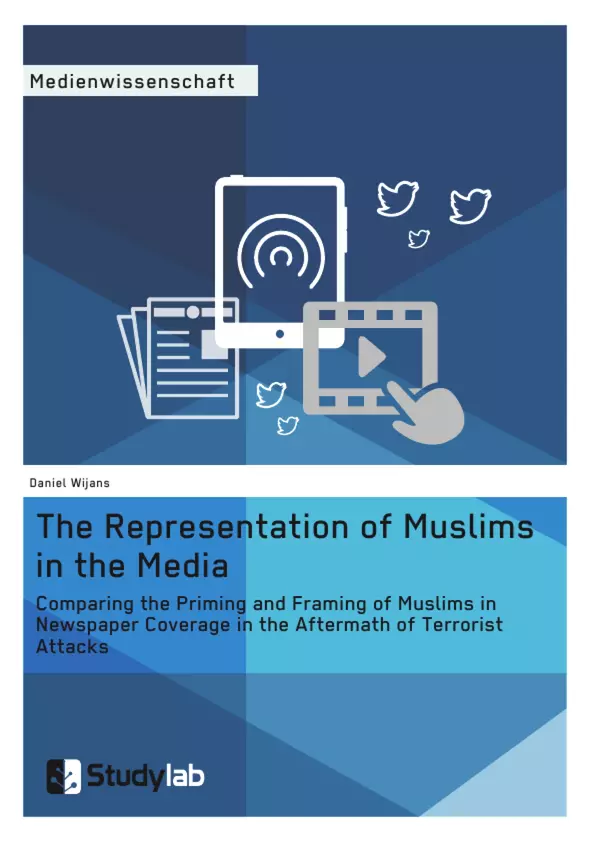The Media can problematize, marginalize, exclude or sterotype social groups. This is often done by writing or speaking negatively about other social groups through text or talk.
The purpose of this study is to linguistically examine the creation of a stereotyped image of Muslims through priming and framing in the media. Hence, this study explores if a stereotyped image of Muslims was identified in Dutch and British mainstream newspapers –De Volkskrant, Trouw, NRC, De Telegraaf, The Guardian, The Daily Mirror, The Daily Telegraph and the Sun– in the aftermath of the terrorist attack on Theo van Gogh in 2004, the 7/7 attacks in 2005 and the Charlie Hebdo attack 2015.
In this way, this study is primarily occupied with; (1) if a stereotyped image of Muslims is created through language; (2) the agenda setting of Muslims; (3) the language used by journalists to describe Muslims in response to terrorist attacks at home or abroad.
The analysis of language in the newspapers is conducted from a critical discourse analysis perspective and is done for both countries separately. The analysis of Dutch newspapers provides more evidence of stereotyped frames compared to the UK but there is not enough evidence to claim that any of the eight newspapers created a stereotyped image of Muslims in the aftermath of the studied terrorist attacks.
Includes:
- Priming Theory;
- Agenda Setting Theory;
- Framing Theory;
- Critical Discourse Analytics;
- Priming of Muslims in Newspapers;
- Framing of Muslims in Newspapers
Inhaltsverzeichnis (Table of Contents)
- Acknowledgement
- Introduction
- Literature Review
- Methodology
- Findings
- Discussion
- Conclusion
Zielsetzung und Themenschwerpunkte (Objectives and Key Themes)
This dissertation aims to analyze how Muslims are represented in the media, specifically comparing newspaper coverage in the Netherlands and the UK in the aftermath of terrorist attacks. The study explores the priming and framing of Muslims in these contexts, investigating the role of media in shaping public perceptions.
- The impact of terrorist attacks on media representation of Muslims
- Comparative analysis of media coverage in the Netherlands and the UK
- The role of priming and framing in shaping public perceptions of Muslims
- The influence of media on public opinion and societal discourse
- The consequences of negative media representations on Muslim communities
Zusammenfassung der Kapitel (Chapter Summaries)
- Introduction: This chapter provides an overview of the research topic, outlining the motivation for the study, the research questions, and the theoretical framework. It also introduces the key concepts of priming and framing and their relevance to media representations of Muslims.
- Literature Review: This chapter presents a comprehensive review of existing literature on media representations of Muslims, focusing on key theories, concepts, and empirical findings. It examines the historical context of media portrayals of Muslims, explores the impact of terrorism on these representations, and discusses the role of media in shaping public opinion.
- Methodology: This chapter describes the research methodology employed in the study, including the data collection methods, the specific newspapers analyzed, and the analytical framework used to examine the data. It also discusses the limitations of the study and the potential biases inherent in the data.
- Findings: This chapter presents the main findings of the analysis, highlighting the key themes and patterns observed in the newspaper coverage of Muslims in the Netherlands and the UK. It explores the specific ways in which Muslims were primed and framed in the media, and the implications of these representations for public understanding.
- Discussion: This chapter discusses the findings in greater depth, analyzing the significance of the results and their implications for media studies, cultural studies, and social policy. It explores the broader societal consequences of the media representations of Muslims, and considers potential solutions to address the issues identified in the study.
Schlüsselwörter (Keywords)
The dissertation focuses on the following key themes and concepts: media representation, Muslims, terrorism, priming, framing, newspaper coverage, Netherlands, UK, public perception, Islamophobia, intercultural communication, and social impact.
- Arbeit zitieren
- MA International Relations Daniel Wijnans (Autor:in), 2015, The Representation of Muslims in the Media, München, GRIN Verlag, https://www.grin.com/document/316255



